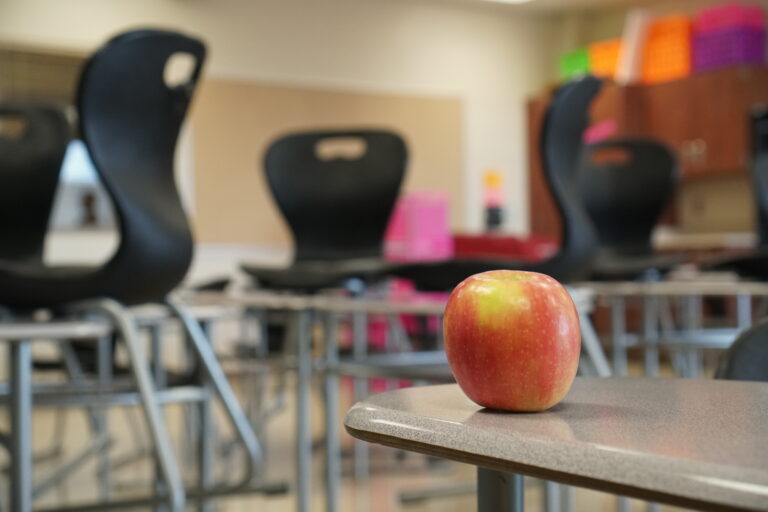ROCKFORD — With the new school year starting, reports of a “national teacher shortage” are at an all-time high. But is staffing a school actually way harder this year than previous years?
Is there a teacher shortage? A superintendent at a small school district in rural Illinois might tell you about how elementary teacher positions that used to attract 100 applicants now get three.
Listen to this story here.
Jay Streicher is the superintendent of Somonauk Public Schools, home to about 700 students. He’d also mention how their high school science teacher resigned before last year and he couldn’t find a replacement.
“We had to go an entire year by having our kids learn chemistry on a computer,” he said. “So, you’re never doing an experiment. Everything is just in front of a computer. Our kids deserve better.”
But stories like that aside, is there a teacher shortage? Other education advocates say no. If they’re having trouble hiring and keeping teachers, those advocates say, it’s because they’re not paid enough to teach under pandemic stress with school board battles over issues like COVID masking seeping into the classroom.
Rich Faivre is the superintendent of another small, rural school district: Earlville. He says he understands the pressure his staff have been under the past few years.
“Why would a new teacher want to go in and come into the profession,” he said, “when those of us that are in it are reporting such high levels of stress?”
So, is there a teacher shortage? Paul Bruno would prefer that I — and everyone else — would stop using that phrase. He’s an assistant professor of education policy, organization, and leadership at the University of Illinois.
He just published a piece in Education Next about how it’s important to clarify what we mean when we talk about teacher hiring issues. For example, staffing problems are specific: certain positions like special education, bilingual, & science are harder to fill than English. And filling those jobs in low-income communities downstate Illinois is much different than in an affluent suburb where pay is a lot higher.
“It’s the students who are already most disadvantaged in various ways,” said Bruno, “who are often in classrooms that are the hardest to staff.”
Those real challenges are complicated, he says. And by talking about shortages broadly, he fears it doesn’t help with finding solutions.
He points out that Illinois schools are employing more teachers than a few years ago, even with fewer enrolled students.
“It’s not just a question of how many people are we certifying to be teachers? How many people are willing to be teachers?,” Bruno said. “It’s also a question of, are they willing to be teachers and the schools we want them to work?”
Jason Pope is tasked with trying to fill vacancies at Rockford Public Schools, Illinois’ third-largest district. He’s RPS’ director of recruitment. The district has around 5,000 employees. They have fewer than 100 unfilled staff positions, which he says is a typical number. Pope says they’re in really good shape compared to last year with support positions like nutrition and transportation workers.
“When we look at teaching vacancies, we’re probably right on target with where we were last year, and same with paraprofessionals,” said Pope. “So, I’d compare this year to last year, with us being maybe in just slightly better shape than we were last year.”
He says they have been offering signing bonuses for difficult-to-fill teaching & support positions, including bus drivers. But the staffing solution they’ve invested the most in are “pipelines.” That includes a partnership with Northern Illinois University to promote paraprofessionals into hard-to-hire special education jobs.
In DeKalb, Deetra Sallis says she saw more teachers than usual leave the profession after last year. At this point, she says they have “a few” vacant classroom positions, and are trying to address that.
“There is language in our collective bargaining agreements about class size,” she said. “But we have started some preliminary discussions with our DCTA teachers union about some alternative teaching models.”
Sometimes when teaching positions go unfilled, classrooms get combined. In many school districts, including Somonauk, that happened a lot last year — particularly when teachers were out with COVID quarantines. Substitutes were especially hard to come by then, so, superintendent Jay Streicher says, they added an incentive.
“We called it the bobcat loyalty rate,” he said. “If you work for us for five days, we increase the pay from $106 a day to $250. Whatever we got to do to try to get him in the door.”
When it comes to licensed teaching positions, Streicher says, unlike last year when they went without a high school science teacher, this year they’re fully staffed.
The same is true for rural Earlville, totally staffed for this year. Federal COVID money came in the clutch for them. Thanks to that extra cash, they were able to hire five additional staff members.
Superintendent Rich Faivre has thought a lot about ways to keep the good teachers he already has. He says they’ve bumped up some base salaries and pay scale incentives for experienced education. They even started a daycare program for their teachers’ families.
“Teachers are able to bring their kids to the daycare in the community too. But it’s nice to have a daycare on site,” said Faivre. “And we applied for and received a tuition waiver with the state so teachers who live out of district can bring their kids to Earlville tuition free.”
School staffing is complex, and there are many legitimate challenges for schools trying to hire. But people like Paul Bruno say that’s why it’s important to home in on exactly where staffing issues exist and who they affect — so education leaders know where to target support.

